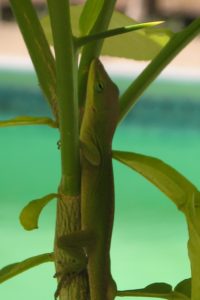
The Carolina Anole
Kingdom: Animalia
Phylum: Chordata
Class: Reptilia
Order: Squamata
Family: Polychrotidae
Genus: Anolis
Species: A. carolinensis
The Carolina anole (Anolis carolinensis) is an arboreal lizard found primarily in the southeastern United States and some Caribbean islands. Other common names include the green anole, American anole and red-throated anole. It is sometimes referred to as the American chameleon due to its color-changing abilities; however, many lizards are capable of this, and anoles are not true chameleons. They are small lizards, usually measuring 6-8 in long, about half of which is comprised by tail, and weighing 3–7 g (0.11–0.25 oz). This species is native to North America, where it is found mainly in the southeastern parts of the continent.
Anoles are often territorial. Some have even been witnessed fighting their own reflections in mirrored glass. Like many lizards, anoles display autotomy of the tail to escape predation.
Anoles are curious creatures. A healthy lizard usually has a good awareness of its surroundings. The males are very territorial and will fight other males to defend its territory.
The anole’s diet consists of small insects such as crickets and grasshoppers; it also eats grasses.
The typical breeding season for green anoles starts as early as April and ends as late as August or occasionally into September. During this time, the most brilliant displays of these creatures can be seen, as the males must court the females with their elaborate displays by extending their brightly colored dewlaps while bobbing up and down, almost doing a dance. The male will court and pursue a female until the two successfully mate. Usually, when the female is ready to mate, she may let the male simply “catch” her and he will thus grasp a fold of her skin above her neck area, or she will bow her head before him and simply “let” him take his grasp. At this point, the male will position his tail underneath the females near her vent and mating will take place.
About two to four weeks following mating, the female will lay her first clutch of eggs, usually ranging from 1–2 in the first clutch. She will continue to lay eggs during the season until about 10 eggs have been produced; she will bury them in the soft soils or compost nearby. The eggs are left to incubate by the light of the sun, and if successful, will hatch in 30–45 days.
The hatchlings must fend for themselves. Anoles are by nature solitary animals since birth, and are not cared for by either parent. The young hatchlings must be wary of other adult anoles, as well as larger reptiles and mammals, which could eat them.
The typical coloration for a green anole ranges from the richest and brightest of greens to the darkest of browns, with little variation in between. The color spectrum is a result of three layers of pigment cells or chromatophores: the xanthophores, responsible for the yellow pigmentation; cyanophores, responsible for the blue pigmentation, and melanophores, responsible for the brown and black pigmentation when the anole is cold or stressed. A lack in one of the pigment genes causes color exceptions. These color mutations are also called phases. The rare blue-phased green anole lacks xanthophores, which results in a blue, rather than red, often baby or pastel blue, anole. These specimens have become popular recently in the pet trade market. When the anole is completely lacking xanthophores, it is said to be axanthic and the animal will have a completely pastel or baby-blue hue. They are extremely rare—usually produced in one of every 20,000 individual anoles in the wild. Another phase is the yellow-phased green anole, which lacks cyanophores. Colonies of these rare color-phased anoles have been reported, but anoles with these color mutations rarely live for long, since the green color provides camouflage for hunting down prey, as well as hiding from predators.
Green anoles are the only anole lizard native to North America. They are very common throughout their distribution, typically found on the sides of buildings, on shrubs or vines, and high in trees. They periodically are found on the ground. Both males and females have a pink throat fan (dewlap), which is used as a means for inter- and intraspecific communication. Their toes are expanded at the tips to accommodate adhesive toe pads, which aid them in climbing smooth surfaces where claws cannot be used.
The green anole has been a particularly important organism for study in the scientific community, and has been successfully used as a model system for studying neurological disorders and for studying drug delivery systems and biochemical pathways relevant to human illnesses. They have also been essential for scientific progress in understanding other aspects of physiology and behavior in animals. The Genus Anolis, which includes over 350 recognized species, also serves as a group of major interest for exploring the evolutionary diversification; of particular interest is the repeated convergent pattern of adaptive radiation on islands of the Greater Antilles, producing on each island essentially the same set of habitat specialists adapted to use different parts of the environment. In recent years, populations of A. carolinensis have apparently become less common, although no data are available. This decline is correlated with massive habitat alteration and the introduction of the brown anole (Anolis sagrei) from Cuba.



